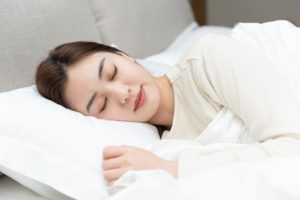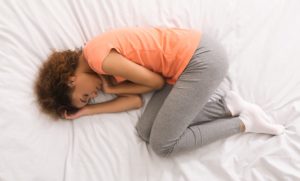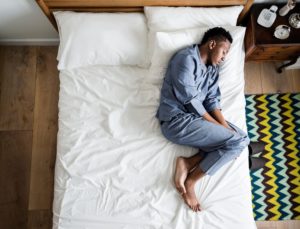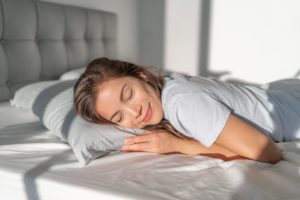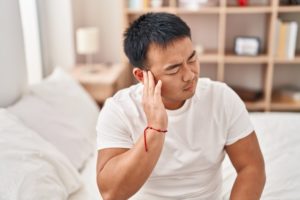When you buy through our links, we may earn a commission. Products or services may be offered by an affiliated entity. Learn more.
Best Sleeping Position for Breathing Problems
- Side sleeping is typically the recommended position for sleep-related breathing problems.
- While stomach sleeping has had mixed results, back sleeping generally has the most negative effects on breathing.
- A variety of conditions can cause respiratory issues and be exacerbated by lying down.
- Consider doing breathing exercises, alleviating congestion, and elevating your upper body before going to sleep.
Many people have a preferred sleeping position that helps them feel comfortable throughout the night. However, some sleep positions, like back sleeping, may cause or worsen certain breathing problems. Experts typically recommend sleeping on the side as the best position for breathing problems like snoring and pauses in breathing caused by obstructive sleep apnea.
Side Sleeping
Though side sleeping is helpful for some respiratory issues, the best sleeping position for breathing problems depends on the cause of a person’s symptoms. For example, side sleeping may help to reduce snoring and back pain and is usually the most comfortable sleep position during pregnancy.
People with obstructive sleep apnea (OSA) may also benefit the most from sleeping on their sides, as this position has been shown to reduce the number of breathing problems they experience. Some research suggests that sleeping on the right side may be the most effective at decreasing breathing problems related to OSA.
However, side sleeping can result in shoulder or neck pain for some sleepers. Using a pillow and mattress designed for side sleeping could offer the right amount of support and align the spine . Additionally, sleeping with a pillow between the legs may reduce back pain in people new to side sleeping.
Stomach Sleeping
Research exploring how stomach sleeping affects breathing has mixed results. Some studies suggest that sleeping on the stomach could reduce breathing pauses and increase oxygen in people with obstructive sleep apnea. However, other evidence shows that switching from the side to the stomach can make breathing more difficult for some people with OSA.
Stomach sleepers should consider looking for a mattress and pillow made for this sleep position. Mattresses should provide a mix of comfort and support, while pillows should support the head and cheeks while offering an open space for nose and mouth breathing.
Back Sleeping
Back sleeping has the most negative effects on breathing for people with obstructive sleep apnea. People with OSA may experience more breathing pauses during the night if they sleep on their backs. Snoring and gastrointestinal reflux can also increase with back sleeping, as can breathing problems related to COPD.
People who prefer to sleep on their backs may find it helpful to keep their heads elevated with a supportive pillow, which may improve issues like snoring, acid reflux, and breathing difficulties from COPD . Placing a pillow under the knees may also relieve pressure on the spine.
What Causes Difficulty Breathing When Lying Down
Some sleep-related breathing disorders and other health conditions can make it more difficult to breathe when lying down or sleeping.
- Obstructive sleep apnea: People with obstructive sleep apnea experience breathing pauses during sleep and may wake up gasping for air.
- Chronic obstructive pulmonary disease: Chronic obstructive pulmonary disease (COPD) affects the lungs and airways, making it difficult to breathe. People with COPD may frequently cough, wheeze, or feel short of breath, which can make sleeping difficult.
- Anxiety: Anxiety can cause shortness of breath during moments of panic or worry. People with anxiety disorders can experience persistent symptoms at any time, including at bedtime.
- Problems with sinuses or nasal passages: Congestion caused by allergies, rhinitis, or other conditions affecting the nasal passages can make breathing difficult, especially when lying down.
- Heart failure: Heart failure can cause shortness of breath that gets worse as the condition progresses. Breathing difficulties may increase when lying flat on the back.
A wide variety of other conditions can affect the respiratory system and interfere with breathing, when lying down or sleeping. For instance, people with diaphragm weakness may feel short of breath lying on their backs.
How to Help Shortness of Breath
Strategies to reduce shortness of breath depend on the cause of this symptom. Before trying to improve breathing at home, it’s important to work with a doctor to understand the cause of shortness of breath and whether it requires additional treatments.
For breathing difficulties related to anxiety, consider trying breathing exercises, like pursed lips breathing before bed. These exercises can help you relax for bedtime and may become more effective with regular practice.
In people with COPD who experience shortness of breath, doctors may recommend strategies to strengthen the muscles of the lungs , including exercise regimens and breathing techniques. Doctors may suggest yogic breathing techniques, breathing with feedback from a computer, and breathing styles that help clear the lungs of mucus.
When To Talk to Your Doctor About Breathing Problems
While mild shortness of breath is expected after strenuous activities, it’s important to contact a medical professional if breathing problems are new, unexpected, severe, or get worse over time.
It can also be helpful to consult your doctor if your breathing problems during sleep lead to insomnia symptoms, like frequent night wakings or daytime sleepiness. Your doctor may suggest further testing or a sleep study to determine what might be causing your breathing problems.

Still have questions? Ask our community!
Join our Sleep Care Community — a trusted hub of sleep health professionals, product specialists, and people just like you. Whether you need expert sleep advice for your insomnia or you’re searching for the perfect mattress, we’ve got you covered. Get personalized guidance from the experts who know sleep best.
References
8 Sources
-
Ozeke, O., Erturk, O., Gungor, M., Hızel, S. B., Aydın, D., Celenk, M. K., Dıncer, H., Ilıcın, G., Ozgen, F., & Ozer, C. (2012). Influence of the right- versus left-sided sleeping position on the apnea-hypopnea index in patients with sleep apnea. Sleep & Breathing, 16(3), 617-620.
https://pubmed.ncbi.nlm.nih.gov/21678115/ -
Chun-Yiu, J. P., Man-Ha, S. T., & Chak-Lun, A. F. (2021) The effects of pillow designs on neck pain, waking symptoms, neck disability, sleep quality and spinal alignment in adults: A systematic review and meta-analysis. Clinical Biomechanics, 85, 105353.
https://pubmed.ncbi.nlm.nih.gov/33895703/ -
Bidarian-Moniri, A., Nilsson, M., Attia, J., & Ejnell, H. (2015). Mattress and pillow for prone positioning for treatment of obstructive sleep apnoea. Acta Oto-Laryngologica, 135(3), 271-6.
https://pubmed.ncbi.nlm.nih.gov/25649886/ -
Menon, A. & Kumar, M. (2013). Influence of body position on severity of obstructive sleep apnea: A systematic review. ISRN Otolaryngology.
https://pubmed.ncbi.nlm.nih.gov/24223313 -
Khan, B. A., Sodhi, J. S., Zargar, S. A., Javid, G., Yattoo, G. N., Shah, A., Gulzar, G. M., & Khan, M. A. (2012). Effect of bed head elevation during sleep in symptomatic patients of nocturnal gastroesophageal reflux. Journal of Gastroenterology and Hepatology, 27(6), 1078-1082.
https://pubmed.ncbi.nlm.nih.gov/22098332/ -
D’Cruz, R. F., Murphy, P. B., & Kaltsakas, G. (2020). Sleep disordered breathing and chronic obstructive pulmonary disease: A narrative review on classification, pathophysiology and clinical outcomes. Journal of Thoracic Disease, 12(Suppl 2), S202–S216.
https://pubmed.ncbi.nlm.nih.gov/33214924/ -
MedlinePlus: National Library of Medicine (US). (2016, August 16). Breathing problems., Retrieved March 27, 2023, from
https://medlineplus.gov/breathingproblems.html -
National Heart, Lung, and Blood Institute. (2022, March 24). COPD treatment., Retrieved March 27, 2023, from
https://www.nhlbi.nih.gov/health/copd/treatment




